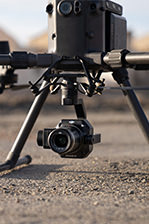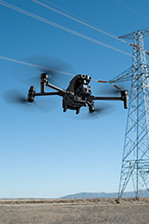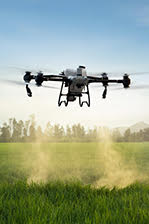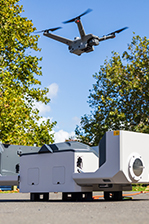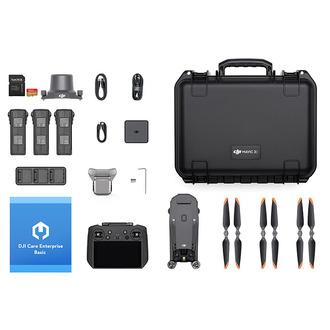DJI Phantom 4 RTK
The Phantom 4 RTK is a must-have tool for every survey professional. A new RTK module offers centimeter-level accuracy with no requirements for ground control points. Connect to a base station via NTRIP with the inbuilt 4G dongle.
Features
Flight Time |
Control Range |
Horizontal RTK Accuracy |
Vertical RTK Accuracy |
Video Transmission |
Obstacle Sensing |
| 30 Min | 7 km | 1 cm + 1 ppm | 1.5 cm + 1 ppm | Ocusync | 5 directions |

DJI has rethought its drone technology from the ground-up, revolutionising its systems to achieve a new standard for drone accuracy - resulting in the creation of the Phantom 4 RTK.
The system was designed by looking at the requirements from the drone mapping and surveying market and building what they wished for - a small drone solution with a high-resolution camera and the ability to capture centimeter-accurate RTK data.
Real Time Kinematics Basics
Real-time Kinematic or RTK is an advanced satellite positioning system utilizing ground station as secondary position reference to delivering highly precise centimetre-level accuracy data.
Combine and contrast position data captured from virtual or physical base station, the Phantom 4 RTK’s camera would geotag the centimetre-level precision data into the image.
Radial and tangential lens distortions were measured for every Phantom 4 RTK’s camera to have its unique distortion parameters and write these distortion parameters into the image for post-process calibration.
Centimetre Level Positioning System
The integrated RTK module provides accurate positioning data even with no GCPs.
Stores the satellite observation data for PPK (Post-Process Kinematic) position post-process.
Compatible with the D-RTK 2 Mobile Station, NTRIP (Network Transport of RTCMv3 via Internet Protocol) and third-party RTK stations (Only PPK is available when the ground station is without the NTRIP service.)
Integrated RTK Module

A new RTK module is integrated directly into the Phantom 4 RTK, providing real-time, centimeter-level positioning data for improved absolute accuracy on image metadata.
Sitting just beneath the RTK receiver is a redundant GNSS module, installed to maintain flight stability in the signal-poor regions such as dense cities.
Combining both GNSS and RTK modules, the Phantom 4 RTK can optimise flight safety while ensuring the most precise data captured for technical surveying, mapping, and inspection workflows.
Ocusync 2.0
Enjoy stable and reliable HD live video transmission at distances of up to 4.3 miles*, the Phantom 4 RTK is great for mapping larger scale sites.
Note: Unobstructed, free of interference, when FCC compliant. Maximum flight range specification is a proxy for radio link strength and resilience. Always fly your drone within visual line of sight unless otherwise permitted.
Precise Imaging System
1-inch CMOS sensor, 20M effective pixels, 2.7 cm GSD (Ground Sample Distance) at 100 m flight altitude.
Radial and tangential lens distortions measured for post-processing image calibration.
The camera is synchronized with the RTK module, delivers millisecond-level imaging deviation.
Phantom 4 RTK’s camera would capture and store the phase compensation data for the post-processing position calibration
The mechanical shutter on Phantom 4 RTK’s camera eliminates rolling shutter distortions which can occur when flying at high speed, allows high-precision shots to capture without the wobble distortion.

Timesync
To take full advantage of the Phantom 4 RTK's positioning modules, the new TimeSync system was created to align the flight controller, camera and RTK module continually.
Additionally, TimeSync ensures each photo uses the most accurate metadata and fixes the positioning data to the centre of the CMOS - optimizing the results from the photogrammetric methods and letting the image achieve centimetre-level positioning data.
Distortion Correction
Enable distortion correction would calibrate the optical distortion caused by the camera lens, real-time calibrated images would be captured and stored in Micro-SD card.
Disable the distortion correction would have Phantom 4 RTK's camera capture the unedited image with the fisheye effect. The lens distortion parameters were all pre-measured. These parameters would all be saved in "DewarpData" under the XMP field for every image taken.
You can also input these parameters manually to calibrate the image distortion with the third-party software. (The location of the principal point should first meet the third-party software. (The position of the primary point should first meet the third-party software's requirements to proceed. Match the imager origin point of the distortion parameter given by XMP with the principal point.) Distortion calibration using post-processing software would have better accuracy compared to the built-in distortion correction feature in the GS RTK app.

For more information, please refer to the following link: Distortion Correction
Remote Controller
Built-in with a 5.5", 1000 cd/m² high-brightness LCD display
Interchangeable battery and antennas design
Phantom 4 RTK's remote controller has a built-in secondary battery to ensure the system would continuously operate while hot swapping external batteries
Latest OcuSync transmission system, transmission range up to 4.3 miles (unobstructed, free of interference)
The remote controller's Multi-Aircraft Control Mode can be used to coordinate the operation of up to five aircraft at the same time, enabling pilots to work efficiently
Supports 4G, Wi-Fi, and OcuSync 2.0 connectivity
Product Specifications
Aircraft
Weight (Battery & Propellers Included) 1391 g
Max Service Ceiling Above Sea Level 19685 ft (6000 m)
Max Ascent Speed 5 m/s
Max Descent Speed 3 m/s
Max Speed 31 mph (50 kph) (P-mode); 36 mph (58 kph) (A-mode)
Max Flight Time Approx. 30 minutes
Operating Temperature 32° to 104° F (0° to 40° C)
Operating Frequency 2.400 GHz to 2.483 GHz (Europe, Japan, Korea)
5.725 GHz to 5.850 GHz (United States, China)
EIRP 2.4 GHz
CE (Europe) / MIC (Japan) / KCC (Korea): < 20 dBm
5.8 GHz
FCC (United States) / SRRC (China): < 26 dBm
Hover Accuracy
Range RTK enabled and functioning properly:
Vertical: ±0.1 m; Horizontal: ±0.1 m
RTK disabled:
Vertical: ±0.1 m (with vision positioning); ±0.5 m (with GNSS positioning)
Horizontal: ±0.3 m (with vision positioning); ±1.5 m (with GNSS positioning)
Image Position Offset The position of the camera centre is relative to the phase centre of the onboard D-RTK
antenna under the aircraft body’s axis: (36, 0, and 192 mm) already applied to the image
coordinates in Exif data. The positive x, y, and z-axes of the aircraft body point to the
forward, rightward, and downward of the aircraft, respectively.
● GNSS
Single-Frequency High-Sensitivity
GNSS
GPS + BeiDou + Galileo* (Asia); GPS + GLONASS + Galileo* (other regions)
Multi-Frequency Multi-System HighPrecision RTK GNSS
Frequency Used
GPS: L1/L2; GLONASS: L1/L2; BeiDou: B1/B2; Galileo*: E1/E5a
First-Fixed Time: < 50 s
Positioning Accuracy: Vertical 1.5 cm + 1 ppm (RMS); Horizontal 1 cm + 1 ppm (RMS).
1 ppm means the error has a 1 mm increase for every 1 km of movement from the aircraft.
Velocity Accuracy: 0.03 m/s
● Mapping Functions
Mapping Accuracy** Mapping accuracy meets the requirements of the ASPRS Accuracy Standards for Digital
Orthophotos Class III.
Ground Sample Distance (GSD) (H/36.5) cm/pixel, H means the aircraft altitude relative to shooting scene (unit: m)
Acquisition Efficiency Max operating area of approx. 1 km2
for a single flight (at an altitude of 182 m, i.e., GSD is
approx. 5 cm/pixel, meeting the requirements of the ASPRS Accuracy Standards for Digital
Orthophotos Class III).
● Gimbal
Controllable Range Pitch: -90° to +30°
● Vision System
Velocity Range ≤ 31 mph (50 kph) at 6.6 ft (2 m) above ground with adequate lighting
Altitude Range 0 - 33 ft (0 - 10 m)
Operating Range 0 - 33 ft (0 - 10 m)
Obstacle Sensory Range 2 - 98 ft (0.7 - 30 m)
Operating Environment Surfaces with clear patterns and adequate lighting (> 15 lux)
● Infrared Sensing System
Obstacle Sensory Range 0.6 - 23 ft (0.2 - 7 m)
Operating Environment Surface with diffuse reflection material, and reflectivity > 8% (such as a wall, trees, humans, etc.)
● Camera
Sensor 1’’ CMOS; Effective pixels: 20M
Lens FOV (Field of View) 84°, 8.8 mm (35 mm format equivalent: 24 mm), f/2.8 - f/11, autofocus
at 1 m - ∞
ISO Range Video: 100 - 3200 (Auto), 100 - 6400 (Manual); Photo: 100 - 3200 (Auto), 100 - 12800 (Manual)
* supported later
** The actual accuracy depends on surrounding lighting and patterns, aircraft altitude, mapping software used, and other factors when
shooting.
In the box
The DJI Phantom 4 RTK includes:
WHY BUY FROM US?
By buying from Ferntech, you'll have the confidence that you are dealing directly with New Zealand's leading drone experts. Our staff are knowledgable drone pilots who offer expert advice, trusted support and superior specialist service. Only through us will you receive a full New Zealand warranty, phone and email support, and access to our certified Repairs Centre with DJI-qualified drone technicians. And we guarantee that we will have the best prices on the market — if not let us know and we will match any price (conditions apply).
Warranty Details
Gimbal Camera: 12 Months
Vision Positioning System: 12 Months
Propulsion system (excluding propellers): 12 Months
Remote Controller: 12 Months
Remote Controller with Built-in Screen (Screen): 12 Months
Remote Controller‘s Battery: 12 Months
Remote Controller‘s Charging Hub: 12 Months
Battery: 12 Months
Battery Charger: 12 Months
Propeller: No warranty
EPP Box: No warranty
Dongle: No warranty
Others: No warranty
Product
1. How does the Phantom 4 RTK differ from previous Phantom Series products?
While previous Phantom series drones were built around professional photographers and hobbyists, the Phantom 4 RTK was designed for industrial users for high-precision mapping and other data acquisition missions. While the Phantom 4 RTK shares a similar camera and form size, it also adds an RTK positioning module, a new TimeSync system, a purpose-built mapping app and more.
2. What propellers does the Phantom 4 RTK use?
The Phantom 4 RTK uses the same 9450s Quick Release Propellers as the Phantom 4 Pro.
3. Can I fly the Phantom 4 RTK in other countries or regions?
No, the Phantom 4 RTK has specific versions for different countries and/or regions. Users can check the version code on the product packaging or through the GS RTK app (go to Aircraft Information -> Firmware).
Camera
1. What is the difference between the Phantom 4 RTK's camera and the camera on the Phantom 4 Advanced/Pro?
While the Phantom 4 RTK and Phantom 4 Pro/Advanced share the same 1-inch, 20 megapixel CMOS sensor, the Phantom 4 RTK has improved the capabilities of the camera for mapping through a new lens distortion recording process. Each Phantom 4 RTK camera goes through a calibration process that measures the distortions of the lens and records the corresponding OPEN-CV parameters. The camera allows users to output the original images without distortion correction as well as the OPEN-CV distortion parameters in the XMP file for post-processing
2. Can the ND filter of the Phantom 4 Pro be used on the Phantom 4 RTK?
Yes, the ND filters made for the Phantom 4 Pro can also be used for the Phantom 4 RTK.
3. Does the Phantom 4 RTK camera digital signal processor (DSP) support distortion correction?
No, you can enable the distortion correction in the camera, but the images will be less precise compared to distortion elimination in post-processing software.
Remote Controller
1. What’s the different between the remote controller of the Phantom 4 RTK and that of the Phantom 4 Pro?
The Phantom 4 RTK's remote controller has multiple changes that add more versatility and features for industrial users. This includes a Micro-SD card slot, a built-in speaker and hot-swappable batteries. Additionally, users can use the remote controller to connect to the internet for Network RTK with a 4G Dongle. Lastly, the new GS RTK App is pre-installed in each remote controller, letting controller start data acquisition missions right out of the box.
2. Can you control the Phantom 4 RTK with the Phantom 4 Advanced/Pro controllers?
No, you cannot control the Phantom 4 RTK with a Phantom 4 Advanced or Pro controller.
3. How can I switch between FCC and CE modes?
FCC and CE mode switching is not available.
4. How do I bind my remote controller with the Phantom 4 RTK?
You can complete the linking through the GS RTK app. Refer to the User Manual for more details.
Video Transmission
1. What is the video transmission distance of the Phantom 4 RTK?
The effective video transmission distance depends on your method of operation (such as the antenna position) and actual flight environment. In an open and unobscured environment, the maximum distance is 7 km when FCC compliant, and 5 km when CE compliant. (2.4GHz).
2. What should I do if the app sends me the following notification: "the remote controller signal is weak, please adjust the antenna"?
This means that improper antenna positioning is likely affecting the video transmission signal, and therefore the quality of the real-time view. You can try to adjust the antennas so the flat sides of the antenna point towards the Phantom 4 RTK.
3. Can I continue my automated mapping mission if the Phantom 4 RTK loses video transmission signal during its mission?
Yes, if the video transmission signal is lost, you can reconnect and continue the mapping mission.
Battery
1. Can I use my Phantom 4 Pro batteries with the Phantom 4 RTK and vice versa?
Yes, the Phantom 4 RTK and Pro batteries are cross compatible and have the same capacity, meaning flight time won't be affected.
2. How long does it take to fully charge a Phantom 4 RTK battery?
It takes roughly 60 minutes to charge a Phantom 4 RTK battery fully.
3. How should I take care of and store my batteries?
Keep the Phantom 4 RTK batteries in a dry place away from water. For long-term storage, ensure the battery is charged to 50% or above and discharge every three months to maintain activity.
4. What does it mean when the battery icon turns yellow in the app?
This means the voltage of the battery cell is below 3.62 V and should be charged soon.
5. Can I use Phantom 4 RTK batteries in low temperatures?
The battery capacity (and therefore flight time) will sharply decrease in low temperatures (< -10℃). It is recommended to heat the batteries to 20℃ before the flight to limit this effect.
6. Why do batteries start to heat up after long-term storage?
This is a normal phenomenon. When batteries have been stored for a long time with over 65% of the charge remaining, an automatic discharging procedure is activated to decrease battery level to 65%, during which the batteries will heat up.
Position And Orientation
1. What options do I have to reference the positioning data from the Phantom 4 RTK?
Connect locally via OcuSync to your D-RTK 2 Mobile Station. (RTCM3.2)
Connect remotely via a 4G Dongle to a custom RTK network using an NTRIP account. (RTCM3.2)
Connect remotely via a WiFi hotspot to a custom RTK network using an NTRIP account. Not available in Europe. (RTCM3.0/RTCM3.1/RTCM3.2)
2. What positioning accuracy can the Phantom 4 RTK achieve?
The Phantom 4 RTK can achieve 1 cm+1 ppm (horizontal), 1.5 cm + 1 ppm (vertical) accurate data.
3. What is TimeSync and how does it ensure the positioning accuracy of each image taken on the Phantom 4 RTK?
TimeSync continually aligns the flight controller, camera and RTK module, then adjusts the positioning data to the centre of the CMOS and records the data in EXIF and XMP format.
4. What are the differences between PPK and RTK mode? How to use them?
RTK and PPK are two different kinematics technologies that reference data in different ways. Although PPK generally has slightly higher positioning accuracy than RTK, both achieve centimetre-level precision. RTK is recommended for users flying in environments that allow for real-time connection via OcuSync or 4G and prefer convenience and efficiency. For users who have no demand for timeliness and need to operate in conditions without connectivity, PPK is a better option.
5. How do I find the XMP information of my Phantom 4 RTK photos?
Open the photo in text format and search "XMP" to find this information on each photo.
6. When I take a photo with the Phantom 4 RTK, where is the location metadata logging the position from?
Due to the new TimeSync system, each photo stores the position of the CMOS centre in its metadata.
7. How can I get the compensation value between the antenna phase centre and CMOS centre?
For each photo, the compensation value between the RTK module's antenna phase centre and the CMOS centre in NED coordinate system is recorded in the timestamp. MRK file under a folder named “survey”.
Software
1. How do I update the Phantom 4 RTK firmware?
The Phantom 4 RTK firmware upgrade process is similar to that of the Phantom 4 Pro. Using the DJI Assistant 2 software, you can update the remote controller and aircraft firmware separately.
You can also update the drone and remote controller simultaneously through the GS RTK app. First, you connect the remote controller to the aircraft with OTG and USB cables, then follow the procedures explained in the remote controller's GS RTK app.
2. In what situations are the left/right TOF and infrared sensors active?
Currently, the left/right TOF and infrared sensors are not active, so please fly with caution.
3. What apps have mapping or inspection function?
Users can use the pre-installed GS RTK app for mapping or inspection missions. Additionally, users can install apps built on DJI's Mobile SDK.
4. Does the Phantom 4 RTK's return to home logic differ from that of the Phantom 4 Pro?
No. The RTH logics in both aircraft are almost the same.
5. Are there any limitations to the Phantom 4 RTK's waypoints?
Yes, the distance between any two waypoints cannot be above 2 km, the total number of waypoints cannot surpass 99, and the entire length of the flight path cannot exceed 15 km.
6. Can I set waypoints by entering longitude and latitude values when using Waypoint mode?
No
7. When importing KML area files with the GS RTK app, what is the maximum number of boundary points that I can set?
Currently, the GS RTK app supports up to 99 boundary points through KML files.
Mapping
1. What formats of differential data does the Phantom 4 RTK support?
Currently, the Phantom 4 RTK supports RTCM 3.0 data, RTCM 3.1 data, MSM4 and MSM5 data under RTCM3.2.
2. Are the coordinates measured by the Phantom 4 RTK relative coordinates or absolute coordinates?
The coordinates measured by the Phantom 4 RTK are absolute coordinates under the coordinate system chosen by users.
3. How do I calculate an appropriate flight altitude based on a GSD value?
You can refer to the equation H=36*GSD to estimate an appropriate flight altitude. Please note that GSD ground sampling distance) in this equation is measured by centimetres, while H (Height or flight altitude) is measured by meters.
4. Do images captured by the Phantom 4 RTK store altitude any information? If so, how is this data stored?
Elevation and relative altitude (relative to your takeoff point) is stored in photos captured by the Phantom 4 RTK. Absolute altitude can be used for mapping, and relative altitude can be found in the XMP file.
5. How can I capture oblique photography when using the Phantom 4 RTK?
Oblique imagery can be captured while flying in the Photogrammetry mode on the GS RTK app. In the Photogrammetry mode, you can adjust the gimbal angle from -90 °to -45° under Camera Settings for your flight plan. You can only set one gimbal angle value at a time, so for sites where you want to capture multiple angles, you can plan the same mission and just adjust the camera angle.
6. Can I create a 3D model or point cloud with third-party software using the images captured by the Phantom 4 RTK? If yes, what is the accuracy of the model created?
Yes, you can use third-party software to process the Phantom 4 RTK image data and create models. However, the accuracy will vary based on the photogrammetric algorithm used. Please refer to the third-party software provider for more information on expected accuracy.
7. What is the best way to use the Phantom 4 RTK to map corridors?
When collecting data over a infrastructure or other narrow corridor, we suggest you set a high overlap ratio, fly the aircraft higher than normal and plan to have at least two flight paths for the whole corridor.
8. Is the Phantom 4 RTK compatible with third-party base stations?
No, you cannot connect third-party base stations to the Phantom 4 RTK or the remote controller via a radio station. However, you can obtain data from a network RTK server via Ntrip protocol in 4G/Wi-Fi network environment. Satellite observation data can also be saved in the aircraft for users to conduct post processed kinematics (PPK) to complete their tasks.
There's currently no reviews for this product, be the first to write one.









